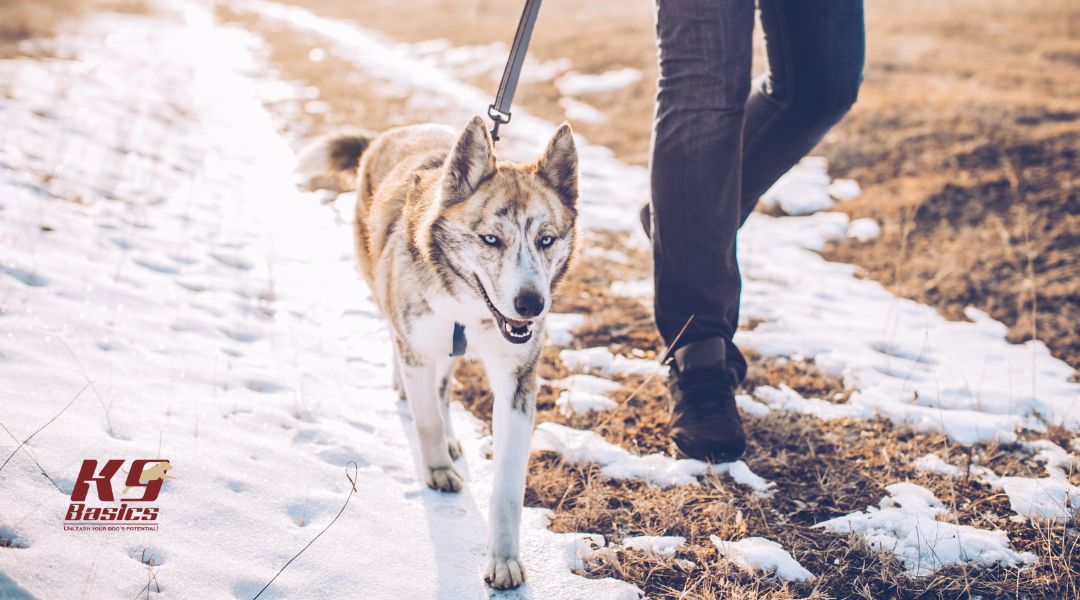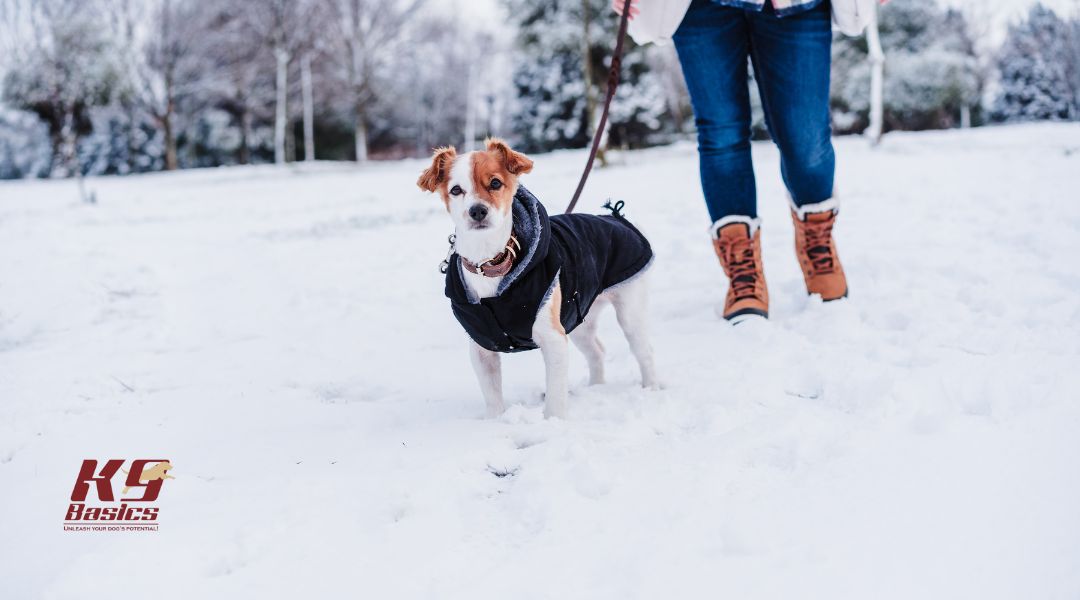Winter walks with your dog can be magical—crisp air, sparkling frost, and the joy of exploring together. But icy streets can turn these outings into a challenge for both you and your furry friend.
Whether it’s ensuring your dog stays calm around slippery surfaces, avoiding sudden pulls, or teaching them to navigate icy patches safely, proper training can make all the difference.
Our certified trainers share simple tips and tricks to help your dog stay well-behaved and safe during winter strolls, ensuring every walk is as enjoyable as a snowy adventure should be! 
5 Challenges of Walking Dogs in Winter
- Slippery Surfaces: Ice and snow create hazardous conditions for both dogs and their owners. Slips and falls are a real risk, so proper footwear and controlled walking are essential for safety.
- Cold Temperatures: Frigid weather can limit the duration of walks, especially for dogs sensitive to cold. Prolonged exposure may also affect your dog’s paw pads, requiring protective gear like booties.
- Heightened Distractions: Snow piles, unfamiliar winter smells, and the presence of other dogs or wildlife and other distractions can overstimulate your dog, leading to pulling or reactive behavior.
- Unprepared Owners: Many dog owners fail to prepare properly for winter walks, whether by wearing inappropriate footwear, neglecting essential training, or forgetting tools like leashes, harnesses, or treats.
- Winter Adoptions: Winter is a popular time for adopting dogs, leaving little opportunity for new pet parents to train their dogs before encountering icy streets and winter-specific challenges.
Why Dog Training Should Be Proactive, Not Reactive
The best time to train your dog isn’t when problems arise but long before they have a chance to develop.
Many dog owners wait until their dog pulls on the leash, reacts to distractions, or behaves unpredictably on icy streets. This approach can make training harder and more stressful for both of you if you’ve recently adopted a dog or plan to work on their leash manners and basic commands right away—even before your first walk.
Proactive group training builds confidence, prevents issues, and ensures your dog knows how to behave regardless of weather conditions!

Training Your Dog Starts Before Stepping Outside
Proper preparation begins before you even open the door. If your dog is overly excited or reactive, they may struggle to focus during the walk.
Start by calming them down indoors. Use basic commands like “sit” and “stay” to establish control and focus.
Don’t forget essentials like a leash, harness, and training treats. Only step outside when your dog is calm and responsive to your instructions.
Start Indoors: Building Control and Focus at Home
Training doesn’t have to begin outdoors; in fact, your home is the perfect controlled environment to teach focus and basic obedience.
Practice walking on a leash indoors, using short commands like “heel” or “wait.” This reduces distractions and helps your dog understand your expectations in a familiar space. You can also practice stopping and starting to simulate real-world conditions.
Pre-Walk Mental Stimulation: Games to Burn Energy
A mentally stimulated dog is a calmer walking companion.
Engage your dog in pre-walk activities like hide-and-seek or puzzle games that challenge their problem-solving skills. These games tire them out mentally and take the edge off their excitement.
You can also use food-dispensing toys or teach them new tricks to focus their energy productively.
Positive Reinforcement to Maintain Focus
Positive reinforcement is key to keeping your dog focused on you during winter walks.
Bring high-value treats or toys your dog loves and reward them for good behavior, like walking calmly by your side or ignoring distractions. Reinforce desired behaviors with consistent praise or rewards, and make the experience enjoyable for your dog.
This approach helps dogs associate walking calmly with positive outcomes, making them more likely to repeat good behavior.
Handle Distractions and Reactivity
Winter streets can be full of unexpected distractions—other dogs, children playing in the snow, or loud snowplows.
If your dog becomes reactive, redirect their attention with a command like “look at me” or “leave it.” Carry treats to reward focus and calm behavior quickly.
If necessary, create distance between your dog and the distraction by crossing the street or pausing.

Essential Gear for Winter Walks
Dog Winter Wear: Protecting Your Pet From the Elements
Just like you layer up in the winter, your dog may need extra protection from the cold.
Depending on your dog’s breed and tolerance for chilly weather, a well-fitting winter coat or sweater can help keep them warm.
At K9 Basics, we show you how to choose the best winter wear for your pet, considering their size, fur length, and activity level. We also emphasize the importance of reflective or brightly colored materials to enhance visibility during darker winter days.
Dog Winter Paw Protection: Avoiding Injuries on Icy Streets
Icy streets, sharp salt crystals, and frigid temperatures can take a toll on your dog’s paws. Protective measures like booties or paw wax can shield their pads from cold and abrasions.
We cover these essential paw care practices, including inspecting your dog’s paws for cracks or injuries after each walk. You’ll also learn how to desensitize your dog to wearing booties, ensuring they stay comfortable and protected throughout the winter.
Regular maintenance, like trimming paw fur to prevent ice buildup, is another skill we teach to keep your dog safe and happy.
Preparing Yourself: Footwear and Equipment for Safe Walks
Your safety is just as important as your dog’s.
Proper footwear with good traction is a must to navigate slippery winter streets. We stress the importance of equipping yourself with the right tools, like gloves for better leash grip, sturdy boots, and even hand warmers for extra comfort. We will also guide you on how to pack a winter-ready training kit, including treats, a secure leash, and waste bags that won’t tear in cold conditions.

Set Your Dog Up for Winter Success With K9 Basics!
Don’t let winter weather prevent enjoyable walks with your dog. At K9 Basics, we provide expert training and guidance to help you and your dog master cold-weather challenges.
From teaching leash manners on icy streets to preparing with the right winter gear, we’ll ensure you and your furry friend are confident, safe, and ready for every snowy adventure.
Call us at (866) 592-2742 or, if you’re from New Jersey, Pennsylvania, Delaware, or New York, visit us at 131 Kenilworth Road, Marlton, NJ 08053, to learn more about our group training classes.
Also, browse our blog and social media for various topics about dogs and their lives with us!
